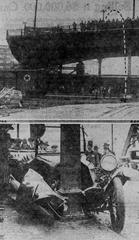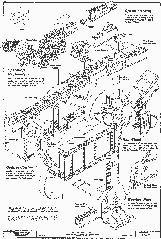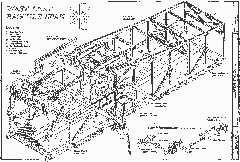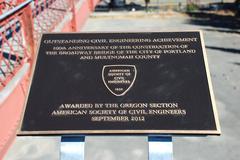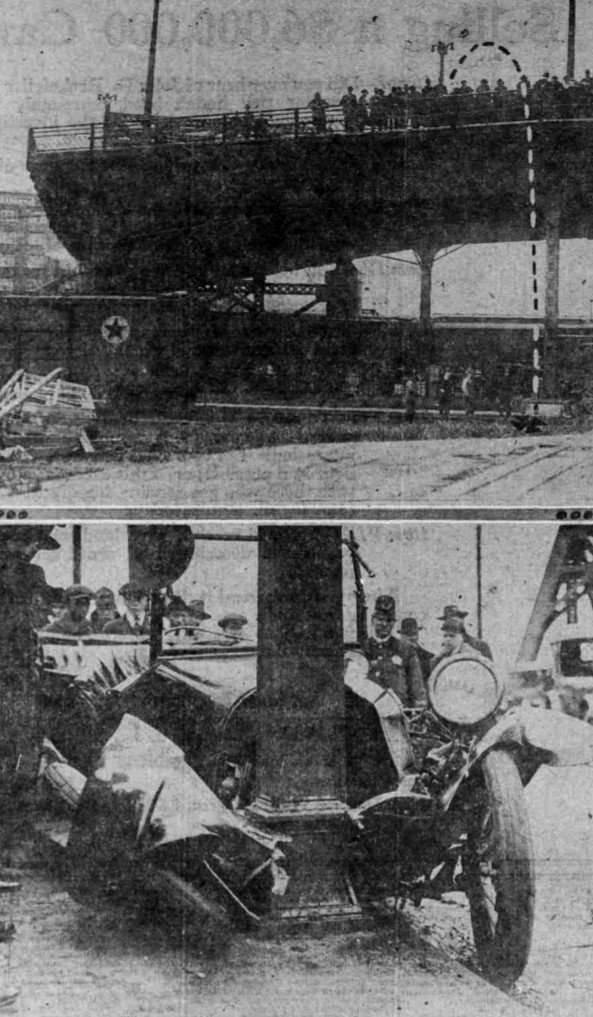
Broadway Bridge Portland: Visiting Hours, Tickets, and Historical Sites Guide
Date: 14/06/2025
Introduction
The Broadway Bridge in Portland, Oregon, is a historic landmark, a marvel of early 20th-century engineering, and a vital artery in the city’s urban landscape. Completed in 1913 and renowned for its iconic “Golden Gate” red color, the bridge stands as a testament to Portland’s growth, innovation, and community spirit. As one of the longest and few remaining Rall-type bascule bridges in the United States, the Broadway Bridge not only connects the city’s east and west sides but also embodies Portland’s identity as “Bridgetown.”
This guide provides a detailed look at the Broadway Bridge’s history, architectural significance, cultural impact, and comprehensive visitor information—including hours, ticketing, accessibility, and tips for an enriching experience. Whether you’re a history buff, architecture enthusiast, or simply seeking scenic views of the Willamette River and Portland skyline, the Broadway Bridge is an essential stop in the city’s tapestry.
For further details, visit HistoricBridges.org, Travel Portland, and the Portland Bureau of Transportation.
Historical Background
Conception and Early 20th Century Context
By the early 1900s, Portland was rapidly expanding, with the Willamette River serving as both a commercial lifeline and a barrier between neighborhoods. The need for reliable, modern crossings led city planners to commission the Broadway Bridge, designed by the acclaimed engineer Ralph Modjeski. Construction began in 1911, and the bridge opened on April 22, 1913, at a cost of approximately $1.6 million—a significant investment at the time (Library of Congress). Its completion marked a new era in Portland’s urban development, facilitating transit, commerce, and the connection of emerging neighborhoods such as the Lloyd and Pearl Districts (oregonessential.com).
Engineering and Design
The Broadway Bridge features a Rall-type bascule design—a rare movable mechanism that combines rolling and trunnion action to efficiently lift the central span for river traffic. At 1,613 feet (492 meters) in length and with a 278-foot (85-meter) main span, it was the longest bridge of its type in the world upon completion (HistoricBridges.org). The steel superstructure, fabricated by the Pennsylvania Steel Company, and the innovative bascule mechanism set new standards for bridge engineering (Wikipedia).
Originally painted black, the bridge was repainted in its now-famous international orange in 1963 to enhance its visibility and distinguish it among Portland’s other bridges.
Architectural and Cultural Significance
Structural Features
The Broadway Bridge consists of six steel through-trusses, with the central span featuring the Rall bascule. Its robust steelwork and distinctive color have made it a visual landmark in the Portland skyline (Travel Portland). The bridge was designed with multimodal transit in mind, originally accommodating streetcars, which have since returned as the Portland Streetcar A and B Loops, alongside buses, vehicles, cyclists, and pedestrians.
Community Symbol
The bridge’s role in connecting neighborhoods and supporting sustainable transportation has reinforced Portland’s reputation as a “Bridgetown.” It is a cherished subject in local art, photography, and merchandise, and features prominently in community events such as the Providence Bridge Pedal and Pedalpalooza (Travel Portland). Its addition to the National Register of Historic Places in 2012 recognizes its architectural and historical importance (Wikipedia).
Preservation and Modern Use
Continuous maintenance and thoughtful renovations—including seismic upgrades and the restoration of streetcar service—have preserved the bridge’s structural integrity while adapting to modern transportation needs (HistoricBridges.org). Multnomah County oversees ongoing preservation efforts, ensuring the bridge remains safe and accessible.
Visitor Information
Visiting Hours and Tickets
- Hours: Open 24/7, year-round. There are no restrictions on pedestrian, bicycle, or vehicular access.
- Entry Fee: None. The bridge is a public thoroughfare and free to cross.
- Public Transit: Regular transit fares apply for the Portland Streetcar and TriMet buses crossing the bridge.
Accessibility
- Pedestrian and Cyclist Access: Wide, level sidewalks and protected bike lanes make the bridge fully accessible to walkers, runners, and cyclists.
- Wheelchair Accessibility: The bridge features curb ramps and ADA-compliant paths at both ends; approaches connect seamlessly to city sidewalks and public transit stops.
- Public Transit: The Portland Streetcar’s A and B Loops cross the bridge. TriMet bus 77 and other lines serve stops nearby (Portland Streetcar).
Experiencing the Broadway Bridge
What to See and Do
- Walking/Biking: Enjoy panoramic views of the Willamette River, downtown skyline, and neighboring bridges from the bridge’s sidewalks and bike lanes (Travel Portland).
- Photography: Sunrise and sunset provide the most dramatic lighting and vistas. The bridge’s red trusses are especially photogenic when reflected in the river.
- Streetcar Ride: Riding the Portland Streetcar across the bridge offers unique perspectives and easy access to both sides of the river.
- Events: Participate in annual events like Providence Bridge Pedal or Pedalpalooza for a festive, car-free experience.
Nearby Neighborhoods and Attractions
- Pearl District (West Side): Art galleries, boutiques, and restaurants.
- Rose Quarter and Lloyd District (East Side): Sports arenas, shopping, and dining.
- Tom McCall Waterfront Park: Jogging, picnicking, and seasonal events.
- Union Station: Historic architecture and Amtrak service.
- Eastbank Esplanade: A popular riverfront path for walking and biking.
Practical Tips for Visiting
- Best Times: Early morning and late afternoon for optimal views and fewer crowds; spring through early fall for the best weather.
- Weather: Dress for Portland’s variable climate; bring rain gear outside of summer.
- Navigation: Use public transit or bike-share services to avoid parking challenges; Google Maps and TriMet apps offer real-time updates.
- Safety: Walk and bike in designated lanes; be alert for bridge openings, which occur periodically for river traffic (Portland Bureau of Transportation).
- Amenities: Restrooms available in nearby parks; abundant local dining options on both sides of the bridge.
- Events: Check event calendars for special closures or festivals that may affect access (PDX Pipeline).
Frequently Asked Questions
Q: What are the Broadway Bridge visiting hours?
A: The bridge is accessible 24/7, year-round.
Q: Is there an entry fee or ticket required?
A: No, access is free for all users. Public transit requires regular fares.
Q: Is the bridge wheelchair accessible?
A: Yes, ADA-compliant sidewalks and curb ramps ensure full accessibility.
Q: Are guided tours available?
A: While the bridge itself does not have permanent tours, it is featured in local walking and historical tours—check with tour operators for schedules.
Q: When does the bridge open for river traffic?
A: The double-leaf bascule span opens periodically, typically for about 20 minutes, to allow ships to pass—check Portland Bureau of Transportation for schedules.
Visuals and Media
- Images: Seek out high-quality photos of the bridge at sunrise, sunset, and during drawbridge operations, with descriptive alt tags such as “Broadway Bridge Portland panoramic view” and “Broadway Bridge pedestrian walkway.”
- Maps: Interactive online maps show the bridge’s location and connections to nearby neighborhoods and transit.
- Virtual Tours: Explore virtual tours and interactive media on Travel Portland.
Sustainability and Responsible Tourism
Support Portland’s sustainable ethos by using public transit, walking, or biking to the bridge, and by disposing of waste responsibly. Enjoy local businesses and respect the city’s green spaces (Travel Portland).
Conclusion
The Broadway Bridge stands as a living symbol of Portland’s past and present, blending historical significance, architectural innovation, and vibrant urban culture. Whether you’re exploring on foot, cycling across its scenic span, or attending a citywide event, the bridge offers a unique vantage point on Portland’s evolution and community life. Use this guide to enhance your visit, and discover why the Broadway Bridge is a must-see for locals and visitors alike.
Further Exploration
Ready to explore more of Portland? Download the Audiala mobile app for guided walking tours, interactive maps, and up-to-date event information. For deeper insights, visit HistoricBridges.org, Travel Portland, and the Portland Bureau of Transportation.
Sources
- Broadway Bridge (Portland, Oregon) - Wikipedia. 2024. (Wikipedia)
- HistoricBridges.org - Broadway Bridge Portland. 2024. (HistoricBridges.org)
- Travel Portland - Portland Bridges and History. 2024. (Travel Portland)
- Portland Bureau of Transportation. 2024. (Portland Bureau of Transportation)
- OregonEssential.com - Bridges Portland Oregon Facts. 2024. (OregonEssential.com)
- Audiala Mobile App - Guided Tours and Maps for Portland. 2024. (Audiala)
